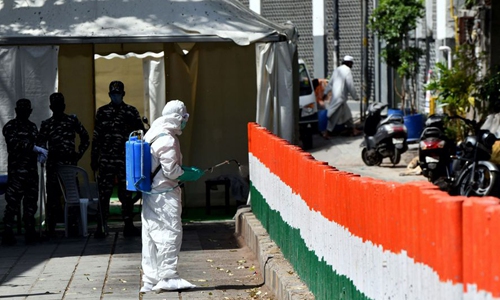
A health worker sanitizes an area near the Nizamuddin mosque in New Delhi, India, on April 10. (Photo: Xinhua)
Economic inequality in India has never been as harsh as it is today.
Reliance Industries Chairman Mukesh Ambani once again overtook Alibaba founder Jack Ma Yun to become Asia's richest person, with his net worth surging to $49.2 billion following a deal with Facebook. By comparison, India's poor are facing the direct threat of famine under the country's unprecedented nationwide lockdown.
For many, India's wealth gap had long been a set of abstract data. According to a study released by Oxfam, India's richest 1 percent hold more than four-times the wealth held by the poorest 70 percent of its population.
And it wasn't until the coronavirus pandemic that we suddenly realized the actual repercussions of the serious inequality in India. Due to the nationwide lockdown, which is aimed at containing the spread of the coronavirus and protecting people's lives, migrant workers worried that they might die of hunger; poor people had to look for food in garbage after losing their jobs; maintaining social distancing is mission impossible for those living in slums; and the poor cannot even get the water to wash their hands, not to mention getting tested for the virus. So, even though the virus does not discriminate, rich and poor alike, the reality is the poor are more likely to be infected and face a disproportionately high death rate.
Fundamentally, the income inequality exposed by the COVID-19 pandemic is a reflection of national capability to a certain extent. In fact, India is not the only country that faces problems in effectively containing the spread of the virus due to the widening gap between the rich and the poor. Countries with serious income inequality all have relatively big troubles in handling the public health crisis.
In the case of the US, the number of coronavirus infections skyrocketed after failing to contain the disease in the first place. Meanwhile, low-income groups are more affected by the virus in terms of the disproportionately high death rate and unemployment, which is mainly caused by the weak state management and intervention capability in the field of social security.
By comparison, many have given high credits to the performance of East Asian countries during the pandemic. And they all have one thing in common in their coronavirus response, which is the strong ability to organize, mobilize and coordinate their social resources to intervene when necessary. European countries like Germany, Sweden, and Denmark, have also demonstrated high competence in allocating medical and social resources to ensure social security.
The lack of strong national capability is the root cause behind India's rising inequality, which is also why the country's poor are suffering so much during the pandemic. With no solution to pare inequality, the government is unable to provide public goods to cover all the poor groups due to its relatively weak implementation of various social security policies. Moreover, the government has poor control over decision-making, which can be easily swayed by various political groups, religions and interested parties, among others. Finally, such weak capability to mobilize the whole society on implementing certain policies and measures has also restricted the country's ability to develop its industries.


